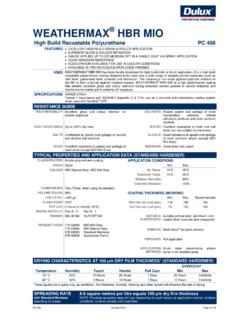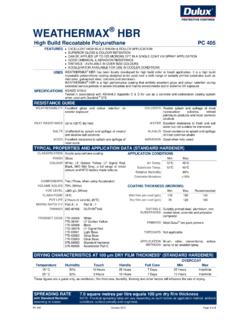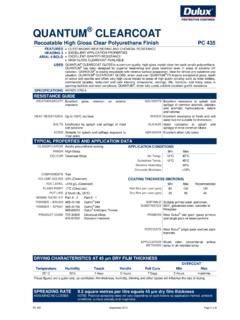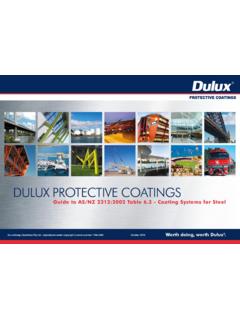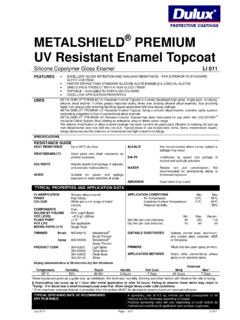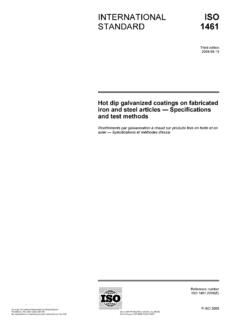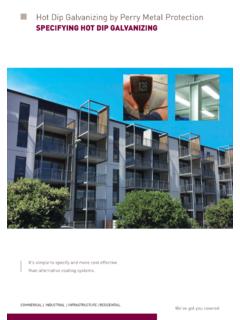Transcription of Hot Dip Galvanising 1.2 - Dulux Protective Coatings
1 HHoott DDiipp GGaallvvaanniissiinngg hot dip Galvanising Sep-09 Page 1 of 2 What Is It, Why Galvanise & What Alternatives Are There? Galvanising is the process of applying a layer of zinc on a steel substrate to provide galvanic corrosion protection. Hot Dipped Galvanising is usually the process most readily identified however, there are other known processes by which zinc can be applied to the steel surface.
2 Galvanising may therefore be achieved in a number of methods, including: Hot Dipped Galvanising (HDG) - involves the dipping of prepared steel into a bath of pure molten zinc metal to form an amalgami of zinc and iron Electro- Galvanising - is the deposition of a metallic film on a prepared surface by electrolysisii. Hot Metal Spray - involves using zinc or zinc alloy wire that is melted in a special spray gun by an electric arc and is then blown onto the prepared surface by compressed air. Zinc-Rich Primers - application of anti-corrosive primers containing high levels of zinc metal powder.
3 In addition to these there are also a number of different zinc alloy products including Zincalume , Duragalv , Zincaneal , etc. A micrograph of a cross section of HDG steel shows that an amalgam of steel and zinc exists between the steel substrate and the zinc layer as shown in the diagram below: Why hot dip Galvanise? Combats corrosion by the zinc coating galvanicallyiii sacrificing itself in place of the mild steel - life span is dependant on environment and thickness of the zinc layer.
4 At have a high surface area/tonne such as open-web hich is useful in construction. The surface may mar under impact stress but will still serve as an anticorrosive coating. Good for small and difficult to paint items steel items thflooring, ladders, handrails, brackets, bolts, girts, purlins etc. Provides good anti-corrosive performance in mild/rural environments. Provides a hard-wearing surface wHHoott DDiipp GGaallvvaanniissiinngg hot dip Galvanising Sep-09 Page 2 of 2 Why NOT hot dip Galvanise?
5 The HDG zinc layer is sensitive to coastal/marine & industrial (chemical) environments - in these environments the pure zinc surface will sacrifice itself at a relatively rapid rate, thus reducing its life considerably. Impractical for large or existing structures - requires to be dipped into a bath of molten zinc, thus large items are restricted by the size of the bath and on site application is not possible. hot dip Galvanising can hide defects and surface contaminants on the surface of the steel.
6 The hot zinc bath may warp and distort items during treatment due to heat involved in the process. This may require extensive reworking. Warping is not always evident until the galvanised sections are delivered to site and the warping prevents assembly! ifficult to manage, and therefore application is usually limited to brush and l itself presents challenges in surface preparation, defects and What Alternatives Are There? decorative purposes, is the application of anti-corrosive primers containing high levels of zinc metal The two mos are: mers, and s Inorganic Zinc Silicate on and use of zinc-rich primers on mild steel, please refer to Dulux PC Tech Note the surface preparation of HDG steel, please refer to Dulux PC Tech Note Surface Preparation Issues.
7 A decorative finish may be difficult to achieve, as HDG steel is generally delivered straight to site rather than to a shop, and therefore paint application is done in the open and subject to wind, rain, airborne salts, dust and insects. Spray application on site is droller. The HDG steecontaminants. As mentioned above, there are three other alternatives. By far the most practical, particularly for steel that is to be painted for powder. st commonly specified zinc-rich primer inorganic zinc silicate pri zinc-rich epoxy primers For more information on the advantages of inorganic zinc silicate Coatings and zinc-rich epoxy primers, please refer to Dulux PC Tech NotePrimers & Organic Zinc Rich Primers.
8 For information on surface Mild Steel What is It? For information on challenges concerning i Amalgam - a mixture or combination. In the case of HDG, the adhesion of the zinc film is a chemical one in that a zinc-iron etal the zinc to corrode in preference to the mild steel, which effectively protects the steel from corrosion as long as the zinc lasts. alloy/mixture is formed immediately on the steel interface. ii Electrolysis - the decomposition of a chemical compound by an electric current.
9 Iii Galvanic - an electrical current occurring as a result of connecting dissimilar metals. Also known as Cathodic . Connecting two different metals together (in the presence of moisture and ions) creates an electrical current between the metals, causing one mto corrode in preference to the other (galvanic corrosion). Contact between mild steel and zinc will caus
